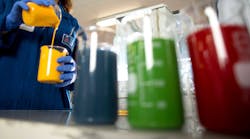In 1866, 24-year-old Henry Sherwin invested $2,000, worth about $32,000 today, into a homer décor and paints dealer, Truman Dunham & Co., based in Cleveland. Three years later, the supplier opened its first factory to process flax into linseed oil, the base for oil paints. By 1870, Sherwin had amassed enough knowledge of paint and its manufacturing to brush over his original partners and draw in Edward P. Williams and Alanson Osborn, thus starting Sherwin Williams & Co. Down the street, John D. Rockefeller formed Standard Oil.
First year sales hit $422,390.97, or $8.7 million by 2018 standards. Last year revenue hit nearly $15 billion. While Mr. Sherwin would be happy to know that's 1,700 times higher than year one, it's possibly more impressive that the global paint and supplies manufacturer experienced a 26% increase from 2016. That, with several other positive metrics, from a 11.83% profit margin to safety record 50% lower than chemical industry average, are a few reasons Sherwin-Williams earned the 10th spot on this year's list of IndustryWeek 50 Best Manufacturers.
A few other bright spots include the fleet of 550 trucks covering 74 million miles last year, 7.3% better than 2016, and a stellar safety rating. The company has 28 Voluntary Protection Program Star sites, 12 OHSAS 18001 sites in the U.S. and 44 ISO 14001 sites globally—more certifications than any other paint and coatings manufacturer, the company says.
Efficiency is always top of mind, with several sites reaching a zero waste designation by making changes as simple as switching to LED lights. And those trucks make trips into big cities at night to avoid traffic and haul materials from vendors on return trips to make the most out of those miles.
"Give Mr. Sherwin the credit," says Joel Baxter, president and general manager of Sherwin-Williams' global supply chain. "He really instilled this 'never rest' mentality."
The Japanese call it kaizen, and we often deem it continuous improvement. In a time when Wild Bill Hickok roamed out West and the internal combustion engine was a mere prototype, Sherwin just knew it as good business.
It led to an uncanny knack for innovation firsts in the industry, mostly involving cans. It became the first to produce its own tin cans, which it then improved by making resealable. Most importantly, in 1875, Sherwin-Williams introduced ready-mixed paint.
Fast forward to this year, and the newest innovation of painting your house without even opening a can. Using the company's mobile app, ColorSnap Visualizer, a user can get a glimpse of what any of the 1,500 paint colors will look like on their walls. With the augmented reality feature called Instant Paint, that's done in real-time.
That's a bold highlight anyone in the general public can use to become potential customers, and possibly become predictive paint addicted to (should I go with Grandeur Plum or Frosted Emerald?). As for the manufacturing innovations going on behind the curtain, that's a horse of a different color, a muted one.
Baxter won't divulge specifics competitors would be eager to learn, but indicates the company's digital transformation goes beyond smartphone apps.
"I would characterize this way: technological innovation has helped us to create better visibility in real-time to make the best decisions for our customers," says Baxter, now in his 28th year with the company. He also says de-siloing departments and the wider use of warehouse management, MRP and ERP software have also fostered a more connected environment up and down the manufacturing supply chain.
Baxter needs that visibility revealed from data insights more than most, as there are dozens and dozens of Sherwin facilities covering the planet, as the famous logo shows.
But technology and innovation are second to the true base: the people, Baxter says.
This employee count expanded to more than 60,000 with the 2017 acquisition of Valspar, and each are given opportunities for advancement.
"We hire and promote for leadership, and we want leaders who care about people " says Baxter, who has seen shop floor workers make it to senior leadership. "The director of a distribution center might have a degree in physics, but the number one trait that makes them a good leader is they care about people."
That caring goes beyond platitudes and pizza parties. Cross-training plays a large role in every facet of the business, from ensuring associates are able to operate several paint lines to providing collaborative team building events to get everyone from R&D to marketing in sync. (Full disclosure: I reported on one of these exercises several years back that did involve teams making pizzas from scratch and designing the boxes, but it wasn't technically a party.)
For a deeper look at how Sherwin-Williams trains IT personnel, visit here.
That starts at the top. Sherwin-Williams has only had nine CEOs, so one every 17 years or so. Henry Sherwin's successor, Walter Cottingham, codified the company tenets in a Code of Principle in the early 20th century, which Baxter says are still in effect in the 5,100 stores and facilities spanning the 100+ nations they operate in.
"All cultures are slightly different and we have to be respectful, but the simple principles, they transfer," he says.
And if they don't?
"It's a non-starter," Baxter replies. "We're not going to compromise on that."
The true key to success may just be that the 152-year-old business treats the quality of its operations with the same reverence as its product, which also transfers to any manufacturer.
"Consistency and repeatability are requirements in the coatings industry, whether painting your home or your car," Baxter explains. "You just have to remain consistent. Improvement doesn't really have a finish line. It can always be made better."








